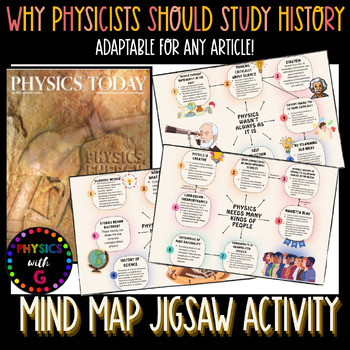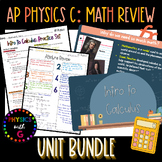Jigsaw Mind Map Activity - Why Should Physicists Study History
- Zip
Also included in
- This unit Bunlde includes 60 pages of notes, lesson plans, unit plans, answer keys, activities, concept maps, and teacher answer keys in addition to 28 editable powerpoint slides. What Content is Covered?Math as a ModelAlgebra Rules for Isolating a VariableSolving Systems of EquationsNewton and LeibPrice $16.16Original Price $17.96Save $1.80
Description
This is the perfect activity to quell those physics fears and get students introduced to your class! Often students come into physics, like any course, with preconcieved notions of what physics is really like. This Jigsaw Mind Map activity helps introduce students to what physics really is about all while building their reading/literacy, organization, and communication skills.
Adaptable Lesson Plan:
This activity, lesson, and sample mind maps are written for the Physics Today article titled " Why Should Physicists Study History?". This is a free article that you can download/print/share with your students. However, you can adapt this lesson plan to fit any article or reading in any class or course.
What's Included?
13 pages of:
- NGSS and Common Core alligned lesson plan
- Lesson plans that include detailed instructions for the Jigsaw activity and the mind maps.
- Blank student copy of the mind maps in color and in black and white.
- Sample Mind Maps for every section of the "Why Should Physicists Study History?" article. These can also be printed out in large scale and laminated to make great classroom posters!
- Suggestions for differentiation, adapting the lessons for other content/articles, and more!
What is a Jigsaw Activity?
Jigsaw activities are a specific type of information gap activity that work best when used with the whole class. The class is first divided into groups of four to six learners who are then given some information on a particular aspect of the topic which they then become the experts in. The class is then re-organized into different groups (‘jigsaw’ groups) of four to six learners so that each learner in the new group is from a different ‘expert’ group and they share their information with the new group so they can complete a task together.
What is a Mind Map or Concept Map?
A Mind Map, or Concept Map, is a diagram for representing tasks, words, concepts, or items linked to and arranged around a central concept or subject using a non-linear graphical layout that allows the user to build an intuitive framework around a central concept. A Mind Map can turn a long list of monotonous information into a colorful, memorable and highly organized diagram that works in line with your brain's natural way of doing things.





